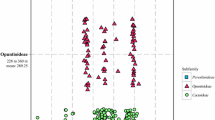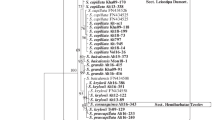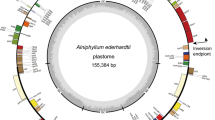Abstract
Seven hundred fifty-two to one thousand ninety-seven base pairs of the trnL intron and trnL–trnF intergenic spacer of the chloroplast DNA of 55 Juncaceae taxa (Juncus, Luzula, Rostkovia, and Oxychloë) was sequenced. Seventeen structural mutations (13 indels marked A to M, 3 parts of the trnF pseudogene, and insertion “o” within a pseudogene) within the chloroplast trnL–trnF region were examined as possible indicators for phylogenetic relationships in Juncaceae. Juncus trifidus (section Steirochloa) was clearly separated from the other taxa by two large (>80 bp) indels. The “Southern Hemisphere clade” was strongly supported by a unique insertion (334 bp) in the trnL intron. The monophyly of Luzula was supported by three small (<10 bp) indels in the trnL-F spacer. They were found in all 22 examined members that represent the taxonomic and geographical diversity of the genus Luzula. A tandemly duplicated tRNA pseudogene was found in the Juncus subgenus Juncus species and is supported by four small unique indels too. The acceptor stem and D-domain-encoding regions are separated by a unique 8-bp insertion. The T-domain and acceptor stem-encoding regions were not found in the pseudogene repeats. Only the Juncus sections Ozophyllum and Iridifolii contain the 5′ acceptor stem, D-domain, and anticodon domain of the tRNAF encoding DNA. The structural mutations in the trnL intron and the trnL–trnF intergenic spacer are useful for phylogenetic reconstruction in the Juncaceae.







Similar content being viewed by others
References
WL Applequist RS Wallace (2002) ArticleTitleDeletions in the plastid trnL–trnF intergenic spacer define clades within Cactaceae subfamily Cactoideae Pl Syst Evol 231 153–162 Occurrence Handle10.1007/s006060200017 Occurrence Handle1:CAS:528:DC%2BD38Xks1yis7Y%3D
FT, Bakker et al. (2000) ArticleTitlePatterns of nucleotide substitution in angiosperm cpDNA trnL(UAA)–trnF(GAA) regions Mol Biol Evol 17 IssueID8 1146–1155 Occurrence Handle1:CAS:528:DC%2BD3cXlvFChu7c%3D Occurrence Handle10991703
BG Baldwin et al. (1995) ArticleTitleThe ITS region of nuclear ribosomal DNA: A valuable source of evidence on angiosperm phylogeny Ann Mo Bot Gard 82 247–277
JJ Doyle JL Doyle (1987) ArticleTitleA rapid DNA isolation procedure for small quantities of fresh leaf tissue Phytochem Bull 19 11–15
L Dráková J Kirschner Č Vlček (2002) ArticleTitleHistorical herbarium specimens in molecular taxonomy of the Juncaceae: A comparison of DNA extraction and amplification protocols Plant Mol Biol Rep 20 IssueID2 161–175
L Drábková J Kirschner O Seberg G Petersen Cø Vlček (2003) ArticleTitlePhylogeny of the Juncaceae based on rbc L sequences, with special emphasis on Luzula DC. and Juncus L Pl Syst Evol 240 133–147 Occurrence Handle10.1007/s00606-003-0001-6
L Gielly P Taberlet (1994) ArticleTitleThe use of chloroplast DNA to resolve plant phylogenies: Noncoding versus rbcL sequences Mol Biol Evol 11 IssueID5 769–777 Occurrence Handle1:CAS:528:DyaK2cXmtVWjtLk%3D Occurrence Handle7968490
TA Hall (1999) ArticleTitleBioEdit: A user-friendly biological sequence alignment editor and analysis program for Windows 95/98/NT Nucl Acids Symp Ser 41 95–98 Occurrence Handle1:CAS:528:DC%2BD3cXhtVyjs7Y%3D
VD, Hipkins et al. (1995) ArticleTitleA mutation hotspot in the chloroplast genome of a conifer (Douglas-fir: Pseudotsuga) is caused by variability in the number of direct repeats from a partially duplicated tRNA gene Curr Genet 27 527–579
J, Hiratsuka et al. (1989) ArticleTitleThe complete sequence of the rice (Oryza sativa) chloroplast genome: Intermolecular recombination between distinct tRNA genes accounts for a major plastid DNA inversion during the evolution of cereals Mol General Genet 217 185–194 Occurrence Handle1:CAS:528:DyaL1MXlt1yjs7k%3D
SA Kelchner (2000) ArticleTitleThe evolution of non-coding chloroplast DNA and its application in plant systematics Ann Miss Bot Gard 87 482–498
SA Kelchner JF Wendel (1996) ArticleTitleHairpins create minute inversions in non-coding regions of chloroplast DNA Curr Genet 30 259–262 Occurrence Handle10.1007/s002940050130 Occurrence Handle1:CAS:528:DyaK28XlvVCgtL8%3D Occurrence Handle8753656
J, Kirschner et al. (1999) ArticleTitleSupraspecific division of the genus Juncus (Juncaceae) Folia Geobot 34 377–390
J, Kirschner et al. (2002a) Juncaceae 1: Rostkovia to Luzula, species plantarum: Flora of the world, part 6 ABRS Canberra 1–237
J, Kirschner et al. (2002b) Juncaceae 2: Juncus subg. Juncus, species plantarum: Flora of the world, part 7 ABRS Canberra 1–237
J, Kirschner et al. (2002c) Juncaceae 3: Juncus subg. Agathryon, species plantarum: Flora of the world, part 8 ABRS Canberra 1–192
THM, Mes et al. (2000) ArticleTitleHairpins involving both inverted and direct repeats are associated with homoplasious indels in non-coding chloroplast DNA of Taraxacum (Lactuceae: Asteraceae) Genome 43 634–641 Occurrence Handle10.1139/gen-43-4-634 Occurrence Handle1:CAS:528:DC%2BD3cXmsVWitbc%3D Occurrence Handle10984175
THM Mes H t′Hart (1994) ArticleTitle Sedum surculosum and S. jaccardianum (Crassulaceae) share a unique 70 bp deletion in the chloroplast DNA trnL (UAA)– trnF(GAA) intergenic spacer Pl Syst Evol 193 213–221 Occurrence Handle1:CAS:528:DyaK2MXkvVSktL8%3D
AM Muasya JJ Bruhl Simpson DA A Culham MW Chase (2000)) Suprageneric phylogeny of Cyperaceae: A combined analysis PJ Rudall PJ Cribb DF Cutler CJ Humpries (Eds) Monocotyledons: Systematics and evolution Royal Botanic Gardens Kew 593–601
SL Munro HP Linder (1998) ArticleTitleThe phylogenetic position of Prionium (Juncaceae) within the order Juncales based on morphological and sequence data Syst Bot 23 IssueID1 43–55
DL, Nickrent et al. (1998) Molecular phylogenetic and evolutionary studies of parasitic plants DE Soltis PS Soltis JJ Doyle (Eds) Molecular systematics of plants II: DNA sequencing Kluwer Academic New York 211–242
VS Novikov (1990) ArticleTitleKonspect sistemy roda Juncus (Juncaceae), [Synopsis of the genus Juncus (Juncaceae)] Bjul Mosk Obšč Ispyt Prir Otd Biol 95 IssueID5 111–125
F Quigley JH Weil (1985) ArticleTitleOrganization and sequence of five tRNA genes and of an unidentified reading frame in the wheat chloroplast genome: Evidence for gene rearrangements during evolution of genomes Curr Genet 9 495–503 Occurrence Handle1:CAS:528:DyaL2MXltlKit78%3D Occurrence Handle3870931
GM Plunkett DE Soltis PS Soltis RE Brooks (1995) ArticleTitlePhylogenetic relationships between Juncaceae and Cyperaceae: Insights from rbcL sequence data Am J Bot 82 IssueID4 520–525
G Rouy (1912) ArticleTitleJoncacées Flore de France 13 222–223
D Simpson (1995) Relationships within Cyperales PJ Rudall PJ Cribb DF Cutler CJ Humpries (Eds) Monocotyledons: Systematics and Evolution Royal Botanic Gardens Kew 497–509
PS Soltis DE Soltis (1998) Molecular evolution of 18S rDNA in angiosperms: Implications for character weighing in phylogenetic analysis DE Soltis PS Soltis JJ Doyle (Eds) Molecular systematics of plants II: DNA sequencing Chapman and Hall New York 188–210
DL Swofford (2002) PAUP*. Phylogenetic analysis using parsimony (* and other methods) version 4.0b10
P Taberlet L Gielly J Bouvet (1991) ArticleTitleUniversal primers for amplification of three non-coding regions of chloroplast DNA Plant Mol Biol 17 1105–1109 Occurrence Handle1:CAS:528:DyaK38Xhslel Occurrence Handle1932684
J, Tsudzuki et al. (1994) ArticleTitleA new gene encoding tRNA-Pro(GGG) is present in chloroplast genome of black pine: A compilation of 32 tRNA genes from black pine chloroplast Curr Genet 26 153–158 Occurrence Handle1:CAS:528:DyaK2cXmsVOksrY%3D Occurrence Handle8001170
K Vijverberg K Bachmann (1999) ArticleTitleMolecular evolution of a tandemly repeated trnF(GAA) gene in the chloroplast genome of Microseris (Asteraceae) and the use of structural mutations in phylogenetic analyses Mol Biol Evol 16 IssueID10 1329–1340 Occurrence Handle1:CAS:528:DyaK1MXms1Ojt7o%3D Occurrence Handle10563014
K Vijverberg THM Mes K Bachmann (1999) ArticleTitleChloroplast DNA evidence for the evolution of Microseris (Asteraceae) in Australia and New Zealand after long-distance dispersal from western North America Am J Bot 86 IssueID10 1448–1463 Occurrence Handle1:CAS:528:DyaK1MXntlaku7Y%3D Occurrence Handle10523285
H Wittzell (1999) ArticleTitleChloroplast DNA variation and reticulate evolution in sexual and apomictic sections of dandelions Mol Ecol 8 2023–2035 Occurrence Handle10.1046/j.1365-294x.1999.00807.x Occurrence Handle1:CAS:528:DC%2BD3cXpvF2lsw%3D%3D Occurrence Handle10632854
M Zuker (1989) ArticleTitleOn finding all suboptimal foldings of an RNA molecule Science 244 48–52 Occurrence Handle1:CAS:528:DyaL1MXkt1SnsbY%3D Occurrence Handle2468181
Acknowledgments
We would like to thank the curators of herbariums AAU, BM, C, and K, where many Juncaceae DNA samples were collected, for their great hospitality. J.K. and L.D. thank T.H.M. Mes and J. Fehrer for fruitful comments on the manuscript. We are grateful to John Novotney for improving the English. The study was done at the DNA Laboratory, Institute of Botany, ASCR, and Laboratory of the Centre for Integrated Genomics and Institute of Molecular Genetics, ASCR, and was supported in part by Grants GACR 206/02/035, GAUK 109/2002/B/BIO, and AVOZ 6005908.
Author information
Authors and Affiliations
Corresponding author
Rights and permissions
About this article
Cite this article
Drábková, L., Kirschner, J., Vlček, Č. et al. TrnL–trnF Intergenic Spacer and trnL Intron Define Major Clades Within Luzula and Juncus (Juncaceae): Importance of Structural Mutations. J Mol Evol 59, 1–10 (2004). https://doi.org/10.1007/s00239-004-2598-7
Received:
Accepted:
Issue Date:
DOI: https://doi.org/10.1007/s00239-004-2598-7




